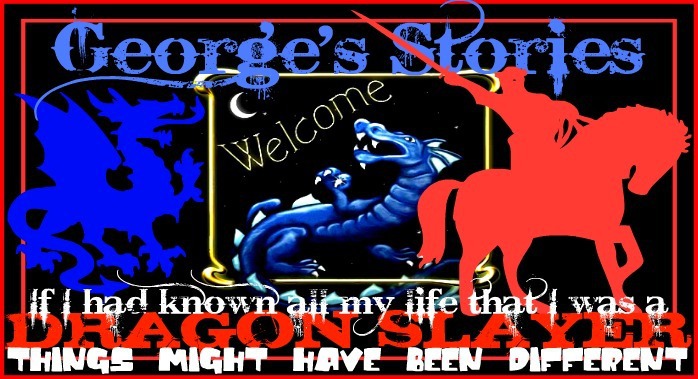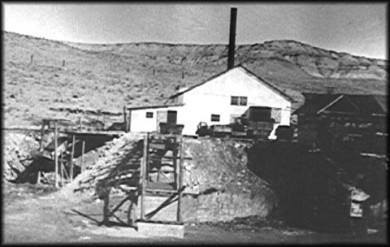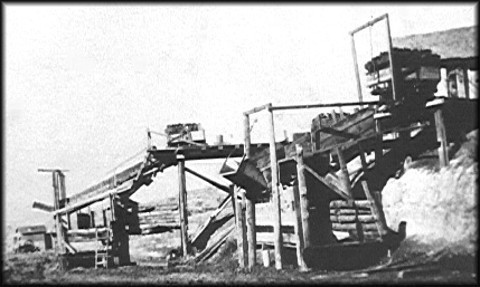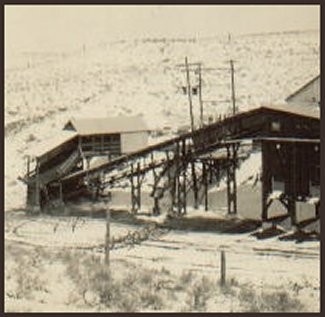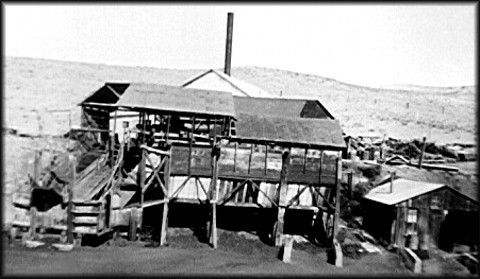The Machinery --- Outside
The Blacksmith Shop
. . . forge---anvil---large hand-powered, wall-mounted drill press---blacksmith hammers---sledges---tongs, and cutting chisels---steam powered hack-saw.
Steam Hoist
. . . with drum capacity of 400' 3/4" steel cable---large lever hand brake and clutch---operated by engaging clutch, turning on steam line valve---the more the valve was opened, the more power and the faster the drum retrieved the cable. The hoist was in the blacksmith shop.
Steam Boiler
The large white building is the Boiler Room, with the high smoke stack. The smaller attached shed-roofed building housed the steam generator. In the center foreground is the new tipple under construction---old tipples on the right and the left. The plateau at the top in the background is under which the main entry made the 90 degree left turn, as described in "A Trip Inside The Mine"
The Steam Boiler was very large---about 30' long x 20' high---with a smoke stack on a concrete base that was about 50' high x 4' diameter. It was made from heavy steel plate 1/8" thick---with 2 x 2-1/8" steel angles rolled in circles and welded to the ends of each 10' section of the stack---matching holes allowed each section to be bolted together when erected.
The cast iron face of the boiler had 2 pairs of fire doors, each about 18" x 18", with each pair 18" x 36"---below the fire doors were an additional set of ash doors Keeping the steam pressure at the required pressure required constant attention. The firebox doors were opened---1 pair at a time---and a long, heavy, steel poker---8 to 10 feet in length---was raked through the burning coals to force the dead ashes into the ash bins below. The heat---almost unbearable. Then, an even layer of coal was shoveled over the remaining burning coals---the process repeated through the second set of fire doors.
Steam Powered Generator
. . . Direct current for underground electrical power inside the mine. The generator had a large fly wheel about 5' in diameter---all painted green, with polished brass fittings through-out---a beautiful---big machine like they used to make!
That big boiler was sometimes unable to supply enough steam to the generator---the demand for electricity in the mine for cutting machines was so great that the generator would have to be shut down until the boiler caught up.
Steam Water Pump
The only other need for steam was to operate the water pump, located in the garage and used to supply the boiler's need for large quantities of water---and for other uses like drinking water and showers.
In the early 30's, REA Electric Service was brought to the mine. A modernization program could now be accomplished with the use of AC power---a new tipple was constructed---new coal storage bins added, with a shaker installed to size the smaller grades of coal. These two units were connected by a long 36" wide, endless conveyer belt system, carrying the coal from the underside of the tipple to the shaker grading system that was installed in the top of the storage bins.
The Tipple
The old Tipple in the foreground, with a loaded car of coal ready to be dumped into the chute---the background shows the new Tipple, with construction almost completed---lacking a corrugated steel roof over the Tipple and the Coal Chute. The larger black rectangular opening under the chute is where the new crusher was installed.
The new tipple--with the conveyor and support structures, from the bin under the chute, to the shaker at the top of the coal storage bins.
The Tipple was the means by which a mine car load of coal could be unloaded and the coal started through the size grading system. It was an elevated platform---constructed of heavy wood timbers and planks, with the narrow gauge mine rails leading a car to the beginning of a steel lined chute---about 30' long, 5' wide, with 24" high, steel-lined planks for sides. The center 10' section of the chute was a heavy steel, bar grate with the bars parallel to the length, and spaced 3" apart. The complete chute was installed at a fairly steep angle to allow gravity to flow the coal over the grating, with all the smaller pieces falling into a hopper below---the larger lumps of coal collected in the bottom 10' of the chute---a small 4' long pivoting chute, stationary at a 45 degree angle, stopped the large lumps of coal in the lower 1/3 of the main chute. This smaller chute could be lowered by winch and cable which allowed the lump coal to flow out the chute and drop into a waiting truck bed.
The tipple name was what happened to the mine car of coal at the top of the chute---the last 4' of track was a connected unit with the end 4' of the track, cut but butting the end of the track leading to the tipple---the unit in turn was U-bolted to a 10' length of 5" pipe. An anchored 3/4" length of rope with 2 half hitches around the end of the pipe was the braking system---a sliding bar lock was released and with a small lift to pipe---track unite---the pipe---the car and load of coal tipped forward and downward. A large hook in the top center of the car, engaged a horizontal bar---the whole front of the mine car was on a pivot and the forward and downward movement opened the front door of the car and the coal dropped into the top of the chute heading for the grate. (One picture would have been worth a thousand words!)
The Shaker
This picture shows the old Tipple and bins---in the foreground, in front of the garage, can be seen the four concrete foundations, which would support the new bins and Shaker. A large building is being dismantled, between the Boiler Room and the Hoist Blacksmith Shop---I have no recollection of this building.
The Shaker was a flat bottomed, steel chute---4' wide x 25' long, with 6" high sides---was suspended from the ceiling of the 3 coal storage bins, by 4 cast iron rocker arms. The 2 at the front end positioned the chute under the conveyer belt and received the coal off the end of the belt. The 2nd pair of rocker arms were 18" longer than the other two, causing the shaker to slant downward, ending over the center of the last bin. The center section of the shaker over the first bin was floored with a perforated steel screen with 1/2" holes which allowed all of the fine coal and dust to be shaken into that bin. The screen over the 2nd bin had 1-1/2" holes which allowed the pea coal to fall into the 2nd bin---off the end of the screen, and the nut coal fell into the 3rd bin. The chute on the tipple produced the coal graded lump and egg---the storage bins produced pea and nut grades---the slake in the 1st bin was a waste product and most was spread on the road to town---instead of gravel. It worked all right but had to be frequently replaced! The road was a country road and was supposed to be maintained by the county, but the mine did the maintaining for it's customers.
The shaker was powered by an AC electric motor with v-belts connecting a pulley and an eccentric, creating the shaking action that flowed the coal down the chute and into it's proper storage bin below the shaker.
The Sheridan Brewery
The Sheridan Brewery was the mine's largest commercial customer. They used pea coal in their stoker-fired boilers. The stoker was an automatic system of delivering the small pea coal to the fire box, with an auger pushing the coal out of the hopper.
I made many trips to the brew rooms with my father (for business reasons). When you entered through a long brick-lined corridor, the first thing that you saw was 20 or 30 copper mugs, hanging from pegs on the wall. Under the mugs were several spigots that flowed cold beer---all you had to do was grab a mug, fill and drink a cold draft of beer. No one enforced liquor laws in those days---if there were any on legal age. The story of beer on the wall is a lead-in to the next story about making enough pea coal to supply the Brewery with the coal---to supply the beer---that Jack (and Jill) drank!!!
The Coal Crusher
The Coal Crusher---was AC powered---had two large revolving steel drums, with hardened-steel teeth welded to the drums. One was adjustable to allow changing the size of the coal that was produced. It was usually set to make pea coal because that's what the beer brewery wanted.
The crusher was installed under the hopper that collected the coal falling through the grate in the chute of the tipple. The coal left the crusher by the long conveyer and was discharged onto the shaker at the top of the high coal storage bins.
